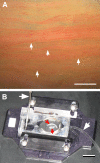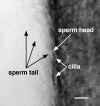Dynamics of Bovine Sperm Interaction with Epithelium Differ Between Oviductal Isthmus and Ampulla
- PMID: 27605344
- PMCID: PMC5176364
- DOI: 10.1095/biolreprod.116.140632
Dynamics of Bovine Sperm Interaction with Epithelium Differ Between Oviductal Isthmus and Ampulla
Abstract
In mammals, many sperm that reach the oviduct are held in a reservoir by binding to epithelium. To leave the reservoir, sperm detach from the epithelium; however, they may bind and detach again as they ascend into the ampulla toward oocytes. In order to elucidate the nature of binding interactions along the oviduct, we compared the effects of bursts of strong fluid flow (as would be caused by oviductal contractions), heparin, and hyperactivation on detachment of bovine sperm bound in vitro to epithelium on intact folds of isthmic and ampullar mucosa. Intact folds of oviductal mucosa were used to represent the strong attachments of epithelial cells to each other and to underlying connective tissue that exist in vivo. Effects of heparin on binding were tested because heparin binds to the Binder of SPerm (BSP) proteins that attach sperm to oviductal epithelium. Sperm bound by their heads to beating cilia on both isthmic and ampullar epithelia and could not be detached by strong bursts of fluid flow. Addition of heparin immediately detached sperm from isthmic epithelium but not ampullar epithelium. Addition of 4-aminopyridine immediately stimulated hyperactivation of sperm but did not detach them from isthmic or ampullar epithelium unless added with heparin. These observations indicate that the nature of binding of sperm to ampullar epithelium differs from that of binding to isthmic epithelium; specifically, sperm bound to isthmic epithelium can be detached by heparin alone, while sperm bound to ampullar epithelium requires both heparin and hyperactivation to detach from the epithelium.
Keywords: fallopian tube; fertilization; heparin; oviduct; spermatozoa.
© 2016 by the Society for the Study of Reproduction, Inc.
Figures









Similar articles
-
Ciliary transport, gamete interaction, and effects of the early embryo in the oviduct: ex vivo analyses using a new digital videomicroscopic system in the cow.Biol Reprod. 2009 Aug;81(2):267-74. doi: 10.1095/biolreprod.108.073874. Epub 2009 Mar 18. Biol Reprod. 2009. PMID: 19299315
-
Characterization of the oviductal sperm reservoir in cattle.Biol Reprod. 1995 Nov;53(5):1066-74. doi: 10.1095/biolreprod53.5.1066. Biol Reprod. 1995. PMID: 8527509
-
Selective sperm binding to pig oviductal epithelium in vitro.Reproduction. 2001 Jun;121(6):889-96. Reproduction. 2001. PMID: 11373175
-
Molecules involved in sperm-oviduct adhesion and release.Theriogenology. 2010 Apr 1;73(6):796-801. doi: 10.1016/j.theriogenology.2009.07.005. Epub 2009 Aug 13. Theriogenology. 2010. PMID: 19682733 Review.
-
Regulation of sperm storage and movement in the ruminant oviduct.Soc Reprod Fertil Suppl. 2010;67:257-66. doi: 10.7313/upo9781907284991.022. Soc Reprod Fertil Suppl. 2010. PMID: 21755678 Review.
Cited by
-
Sperm calcium flux and membrane potential hyperpolarization observed in the Mexican big-eared bat Corynorhinus mexicanus.J Exp Biol. 2023 Jan 15;226(2):jeb244878. doi: 10.1242/jeb.244878. Epub 2023 Jan 30. J Exp Biol. 2023. PMID: 36541225 Free PMC article.
-
Heparin and Progesterone Exert Synergistic Effects to Improve the In-Vitro Fertilization Rate of Bovine Sperm Bound to Oviduct Cell Aggregates from the Isthmus.Vet Sci. 2022 Jul 20;9(7):372. doi: 10.3390/vetsci9070372. Vet Sci. 2022. PMID: 35878389 Free PMC article.
-
Mammalian sperm hyperactivation regulates navigation via physical boundaries and promotes pseudo-chemotaxis.Proc Natl Acad Sci U S A. 2021 Nov 2;118(44):e2107500118. doi: 10.1073/pnas.2107500118. Proc Natl Acad Sci U S A. 2021. PMID: 34716265 Free PMC article.
-
The essential calcium channel of sperm CatSper is temperature-gated.Nat Commun. 2025 Apr 17;16(1):3657. doi: 10.1038/s41467-025-58824-0. Nat Commun. 2025. PMID: 40246904 Free PMC article.
-
Pre-Treatment of Swine Oviductal Epithelial Cells with Progesterone Increases the Sperm Fertilizing Ability in an IVF Model.Animals (Basel). 2022 May 6;12(9):1191. doi: 10.3390/ani12091191. Animals (Basel). 2022. PMID: 35565617 Free PMC article.
References
-
- Suarez SS. Regulation of sperm storage and movement in the mammalian oviduct. Int J Dev Biol. 2008;52:455–462. - PubMed
-
- Gwathmey TM, Ignotz GG, Suarez SS. PDC-109 (BSP-A1/A2) promotes bull sperm binding to oviductal epithelium in vitro and may be involved in forming the oviductal sperm reservoir. Biol Reprod. 2003;69:809–815. - PubMed
-
- Gwathmey TM, Ignotz GG, Mueller JL, Manjunath P, Suarez SS. Bovine seminal plasma proteins PDC-109, BSP-A3, and BSP-30-kDa share functional roles in storing sperm in the oviduct. Biol Reprod. 2006;75:501–507. - PubMed
-
- Ignotz GG, Cho MY, Suarez SS. Annexins are candidate oviductal receptors for bovine sperm surface proteins and thus may serve to hold bovine sperm in the oviductal reservoir. Biol Reprod. 2007;77:906–913. - PubMed
Publication types
MeSH terms
Substances
Grants and funding
LinkOut - more resources
Full Text Sources
Other Literature Sources

